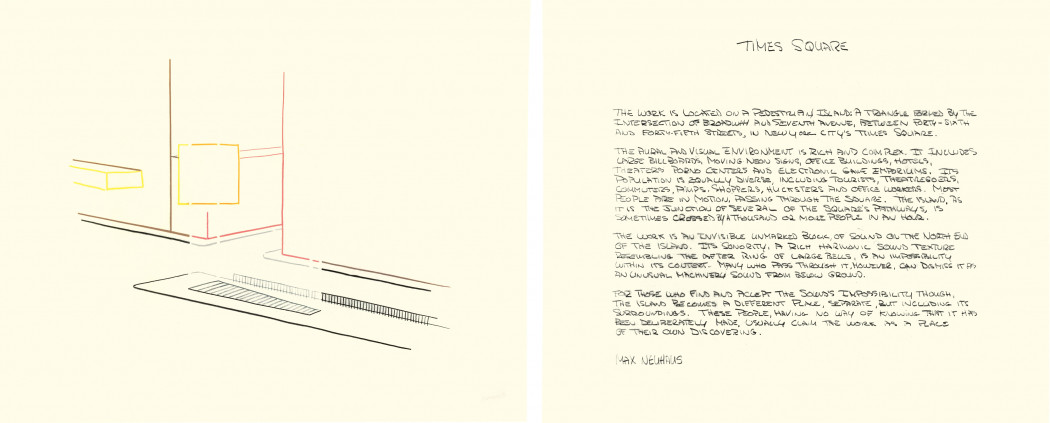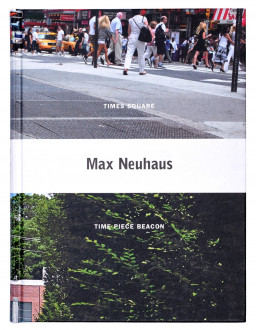Max Neuhaus
Long-term view, Dia Beacon
Overview
A pioneer in the field of contemporary art and music, Max Neuhaus is credited with being the first to use sound as a medium for site-specific installations. His sound installations allow listeners to approach sound as art, in their own time. Testing the idea that our perception of a place depends also on what we hear, Neuhaus extended sound into social spaces to create sites altered by the synthetic, anonymous sounds concealed within them. Commissioned by Dia in 2005, Time Piece Beacon is based on the principle of a “sound signal in reverse,” a subtle sound that is noticed when it disappears rather than when it begins. As each hour approaches, a low tone gradually emerges along the perimeters of the galleries at Dia Beacon, and the hour is signaled when the sound abruptly ends.
Commissioned specifically for Dia:Beacon, Max Neuhaus’s Time Piece Beacon (2005) creates a zone of sound around the perimeter and in the galleries of the museum. As each hour approaches, a low tone gradually emerges, almost imperceptibly increasing in volume; the hour is signaled when the sound abruptly ends, creating what seems a silence in the ambient sonic environment. This is what the artist called a “sound signal in reverse,” a subtle sound that is noticed when it disappears rather than when it begins. This work belongs to a series inspired by a singular early project—a silent alarm clock, designed by Neuhaus in 1979. The device produced a drone that, growing from inaudible to a distinctly haunting volume, would induce the sleeping listener to wake up as the sound shut off. Similarly, in Time Piece Beacon, Neuhaus devised a continuous, gradual sound tapestry pitched at the upper limit of the natural ambient sounds of the area: “Initially inaudible, the sound will gradually emerge from the ambient noise
and then will suddenly stop.” The signal thus becomes the silence that ensues after the cessation of the sound. As another reference that informed the series, Neuhaus recalled the unifying role of bells in early modern societies, gathering the listeners audibly, but also delimiting the spatial perimeter of a community by means of vibrating, tactile sound resonance.
A pioneer in the fields of contemporary art and music, Neuhaus is credited with being the first to explore the role of sound as a primary medium for installations and site-specific pieces. Unlike music, his works are never a succession of changing audio events in time, but continuous markers of “a site as a whole and the different places within it.” For Neuhaus, sound was the material he used to “transform the space into a place.” Neuhaus explained that “trying to capture this work with a recording is as silly as chipping the paint off the canvas, putting it in a box and thinking you still have the painting.” One of a number of works from the Moment series, Time Piece Beacon is premised on perception as a whole, involving sight and hearing and touch—in other words, the visitor’s entire physical presence.
For each project, Neuhaus made a drawing-text diptych. This is what he called a “statement in another medium,” although this statement is mixed since it involves a visual description and a verbal one. Whereas in his drawings Neuhaus experimented with possible graphic and chromatic solutions to
visualize sound, his written notes have surprisingly poetic qualities.
In addition to the presentation of his work in numerous exhibitions over the past forty years, today there are a dozen works by Neuhaus permanently installed in public and private venues. Along with his last installation at the Menil Collection, Houston, in 2008, the two works in Dia’s collection—Time Piece Beacon and Times Square (1977/2002) in New York City—are the only permanent installations by Neuhaus located in North America.
Max Neuhaus was born in 1939 in Texas, and spent his childhood in Fishkill, New York. He began his studies in music at the Manhattan School of Music under Paul Prince’s mentorship. In 1958, he met John Cage, and this encounter determined his decision to become a professional percussionist. After a solo tour in Europe in 1965, Neuhaus started developing projects that went beyond the strictly musical realm; among them were site-specific pieces that he was the first to call “sound installations.” In 1968, as he started a research residency at the Bell Laboratories, Neuhaus ceased performing as a musician and fully devoted himself to sound art. Since then, his work has been exhibited internationally in museums and galleries, including solo shows at the Museum of Modern Art, New York (1978); Musée d’art moderne de la ville de Paris (1983); and the Kunsthalle Bern (1989). He was also included in Documentas 6 (1977) and 9 (1992), Kassel, Germany; the Whitney Biennial, New York (1983); and the Venice Biennale (1999). In 2008, an exhibition of Neuhaus’s drawings was organized by the Menil Collection, Houston, which coincided with the inauguration of a new installation, Sound Line. Neuhaus passed away in February 2009 in Italy.
Artist
Max Neuhaus
Max Neuhaus was born in Beaumont, Texas, in 1939. He died in Maratea, Italy, in 2009.
Selected Works on View

Max Neuhaus
Time Piece Beacon, 2005
Go to Time Piece Beacon pageBooks
Max Neuhaus
This book offers an in-depth look at two Max Neuhaus works in Dia's collection, Times Square and Time Piece Beacon.

